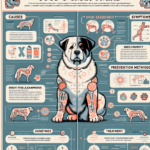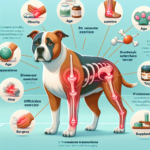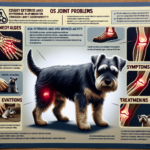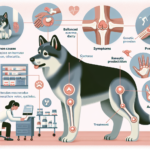Puli Joint Pain: Causes, Symptoms, Prevention, and Treatment

Introduction
The Puli is a distinctive and ancient breed known for its unique corded coat and agile, energetic nature. Originating from Hungary, the Puli was traditionally used as a herding dog, prized for its intelligence, agility, and loyalty. The breed’s history dates back over a thousand years, and it has been a beloved companion and working dog for many generations. Notable features of the Puli include its dense, woolly coat that forms natural cords, and its lively, playful demeanor.
Like many breeds, the Puli is susceptible to certain health issues, with joint pain being a significant concern. Joint health is crucial for maintaining the Puli’s active lifestyle and overall well-being. Understanding the causes, symptoms, prevention, and treatment of joint pain in Pulis can help owners ensure their pets lead healthy, comfortable lives.
Breed-Specific Joint Pain Risks
Genetic Predisposition
The Puli, like many purebred dogs, has a genetic predisposition to certain joint-related issues. Hip dysplasia, a condition where the hip joint does not fit properly into the hip socket, is relatively common in this breed. This can lead to arthritis and significant discomfort over time. Elbow dysplasia, another genetic condition, can also affect Pulis, causing pain and mobility issues in the front legs.
Age-Related Risks
As Pulis age, they become more susceptible to joint pain and related conditions. Arthritis is a common age-related issue that can affect the breed, leading to stiffness, pain, and reduced mobility. Owners should be particularly vigilant as their Puli reaches middle age, typically around 6-8 years old, as this is when joint issues may start to become more apparent.
Activity Level and Joint Stress
Pulis are known for their high energy levels and agility, often participating in activities such as herding, agility competitions, and other dog sports. While regular exercise is essential for their health, excessive or inappropriate activity can place undue stress on their joints. Owners should balance their Puli’s need for exercise with the potential risk of joint strain, especially in younger dogs whose joints are still developing.
Common Symptoms of Joint Pain in Pulis
General Symptoms
- Limping or favoring one leg
- Stiffness, especially after rest
- Reluctance to jump, run, or climb stairs
- Decreased activity or playfulness
- Visible discomfort or pain when moving
- Swelling around the joints
Breed-Specific Symptoms
In Pulis, joint pain may manifest in specific ways due to their unique physical characteristics and activity levels. Owners might notice their Puli having difficulty with activities that require agility and quick movements, such as herding or agility training. Additionally, the breed’s dense coat can sometimes mask subtle signs of joint pain, making it essential for owners to be observant and proactive in monitoring their dog’s behavior and movement.
When to Consult a Vet
If a Puli exhibits any signs of joint pain, it is crucial to consult a veterinarian promptly. Early intervention can prevent further deterioration and improve the dog’s quality of life. Owners should seek veterinary advice if their Puli shows persistent limping, significant changes in activity levels, or any signs of pain or discomfort that do not resolve with rest.
Preventive Measures for Joint Health
Exercise Recommendations
Regular, moderate exercise is vital for maintaining joint health in Pulis. Activities such as walking, swimming, and controlled play can help keep their joints flexible and muscles strong without causing excessive strain. Owners should avoid high-impact activities like jumping or running on hard surfaces, especially for young dogs whose joints are still developing.
Dietary Suggestions
A balanced diet rich in essential nutrients can support joint health in Pulis. Foods containing glucosamine, chondroitin, and omega-3 fatty acids are particularly beneficial for joint maintenance and repair. Owners may also consider supplements specifically designed to promote joint health, but it is essential to consult a veterinarian before adding any new supplements to their dog’s diet.
Weight Management
Maintaining a healthy weight is crucial for reducing joint stress in Pulis. Excess weight can exacerbate joint issues and lead to more severe pain and mobility problems. Owners should monitor their Puli’s weight and adjust their diet and exercise routine as needed to ensure they remain within a healthy weight range.
Early Screening and Monitoring
Regular veterinary check-ups and early screening for joint issues can help catch problems before they become severe. For Pulis, this may include hip and elbow evaluations, especially if there is a family history of joint problems. Early detection allows for timely intervention and better management of joint health.
Treatment Options for Joint Pain
Non-Surgical Treatments
Non-surgical treatments for joint pain in Pulis include medications, physical therapy, and lifestyle adjustments. Anti-inflammatory drugs and pain relievers can help manage pain and reduce inflammation. Physical therapy, including exercises and massage, can improve joint function and mobility. Lifestyle adjustments, such as providing a comfortable bed and avoiding strenuous activities, can also alleviate joint pain.
Surgical Options
In severe cases, surgical intervention may be necessary to address joint pain in Pulis. Common surgical options include hip replacement, arthroscopy, and joint fusion. These procedures can significantly improve the dog’s quality of life, but they come with risks and require a thorough discussion with a veterinarian to determine the best course of action.
Alternative Therapies
Alternative therapies such as acupuncture, hydrotherapy, and massage can provide additional relief for Pulis suffering from joint pain. Acupuncture can help reduce pain and inflammation, while hydrotherapy offers low-impact exercise that supports joint health. Regular massage can improve circulation and reduce muscle tension around the joints.
Lifestyle and Management Tips
Daily Care Routine
A consistent daily care routine can help manage and alleviate joint pain in Pulis. This may include gentle exercise, a balanced diet, and regular grooming to keep their coat in good condition. Owners should also provide a comfortable resting area with supportive bedding to reduce joint stress.
Modifying the Home Environment
Making the home environment more comfortable for a Puli with joint pain can significantly improve their quality of life. This may involve installing ramps to help them navigate stairs, providing orthopedic beds for better support, and ensuring that their living area is free of obstacles that could cause injury.
Long-Term Management
Long-term management of joint pain in Pulis involves regular veterinary check-ups, ongoing monitoring of their condition, and adjustments to their care routine as needed. Owners should remain vigilant for any changes in their dog’s behavior or mobility and be proactive in seeking veterinary advice to ensure their Puli remains active and happy despite joint pain.
FAQs About Pulis and Joint Pain
What are the early signs of joint pain in Pulis?
Early signs of joint pain in Pulis include limping, stiffness, reluctance to move, and decreased activity levels. Owners should also watch for signs of discomfort when their dog is getting up or lying down.
Can joint pain in Pulis be prevented?
While it may not be possible to prevent joint pain entirely, owners can take steps to reduce the risk. This includes providing a balanced diet, maintaining a healthy weight, ensuring regular, moderate exercise, and scheduling regular veterinary check-ups for early detection of joint issues.
Are there specific exercises that are better for Pulis with joint pain?
Low-impact exercises such as walking and swimming are ideal for Pulis with joint pain. These activities help maintain joint flexibility and muscle strength without causing excessive strain. Owners should avoid high-impact activities like jumping or running on hard surfaces.
What dietary supplements can help with joint health in Pulis?
Supplements containing glucosamine, chondroitin, and omega-3 fatty acids can support joint health in Pulis. These nutrients help maintain cartilage, reduce inflammation, and improve joint function. Always consult a veterinarian before adding new supplements to your dog’s diet.
When should I consider surgery for my Puli’s joint pain?
Surgery should be considered when non-surgical treatments are no longer effective, and the dog’s quality of life is significantly impacted by joint pain. A veterinarian can help determine the best course of action based on the severity of the condition and the dog’s overall health.
Conclusion
Joint pain is a significant concern for Pulis, but with proper care and attention, owners can help their dogs lead comfortable and active lives. Understanding the causes, symptoms, prevention, and treatment options for joint pain is crucial for maintaining the health and well-being of this unique and energetic breed. By taking preventive measures, monitoring their dog’s condition, and seeking veterinary advice when needed, owners can ensure their Puli remains happy and healthy for years to come.




